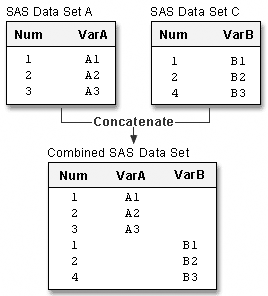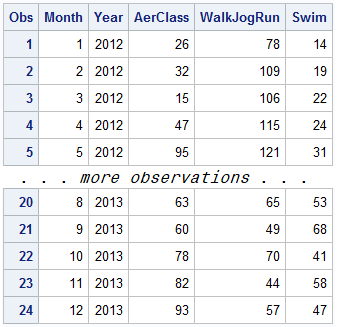Concatenating: Details
Concatenating Syntax
Another way to combine SAS data sets with the SET statement
is concatenating, which appends the observations from one data set
to another data set. To concatenate SAS data sets, you specify a list
of data set names in the SET statement.
|
Syntax, DATA step for
concatenating:
DATA output-SAS-data-set;
SET SAS-data-set-1
SAS-data-set-2;
RUN;
|
How Concatenating Selects Data
When a program concatenates
data sets, all of the observations are read from the first data set
listed in the SET statement. Then all of the observations are read
from the second data set listed, and so on, until all of the listed
data sets have been read. The new data set contains all of the variables
and observations from all of the input data sets.
data concat; set a c; run;
Figure 10.4 How Concatenating Selects

Notice that A and C
contain a common variable named Num:
-
Both instances of Num (or any common variable) must have the same type attribute, or SAS stops processing the DATA step and issues an error message stating that the variables are incompatible.
-
However, if the length attribute is different, SAS takes the length from the first data set that contains the variable. In this case, the length of Num in A determines the length of Num in Concat.
-
The same is true for the label, format, and informat attributes: If any of these attributes are different, SAS takes the attribute from the first data set that contains the variable with that attribute.
Example: Using Concatenating to Combine Data Sets
The
following DATA step creates Work.Concat by concatenating Cert.Therapy2012
and Cert.Therapy2013. Each data set contains 12 observations.
data work.concat; set cert.therapy2012 cert.therapy2013; run; proc print data=work.concat; run;
The first 12 observations
in the new output data set Work.Concat were read from Cert.Therapy2012,
and the last 12 observations were read from Cert.Therapy2013.
Figure 10.5 Example: Concatenating (partial output)

Last updated: August 23, 2018
..................Content has been hidden....................
You can't read the all page of ebook, please click here login for view all page.
